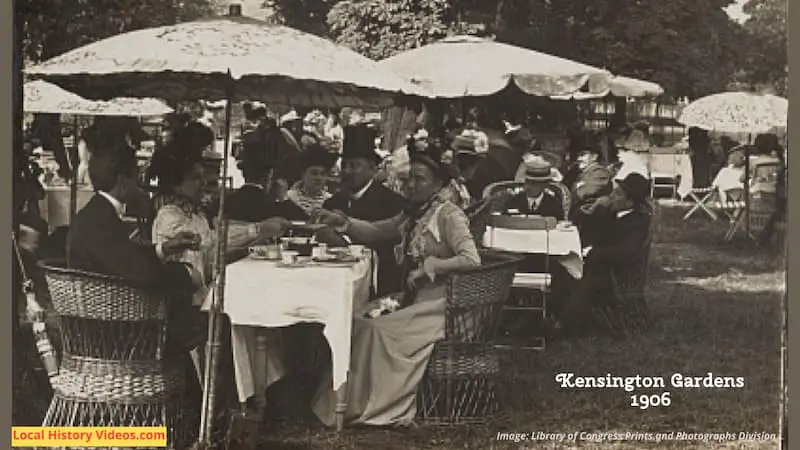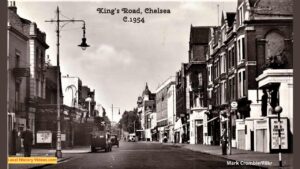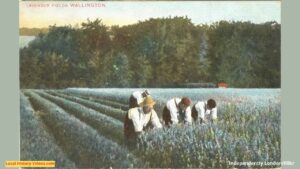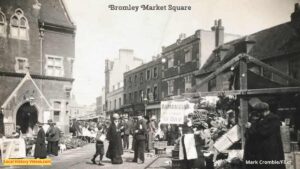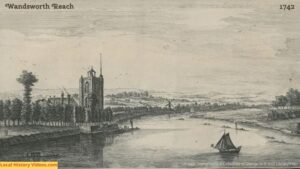Glimpse history through old images of Kensington Gardens, London.
Kensington Gardens in 1926
Claude Friese-Greene’s film ‘The Open Road’ was made in 1925/6. The BFI re-edited and digitally restored the film in the early 21st century.
In this short clip from the film, we can admire Kensington Gardens as they were a century ago.
Kensington Gardens, London (1926) – BFI on YouTube
Troop Camp 1937
Two years before the outbreak of the Second World War, Kensington Gardens hosted a tent encampment of soldiers during the Coronation of King George VI, and his wife Elizabeth, which took place at Westminster Abbey, London, on 12 May 1937.
Coronation troops camp in Kensington Gardens (1937) – British Pathé on YouTube
German PoWs 1946
In 1946, the grounds of Kensington Gardens were prepared for the Victory parade by German prisoners of war, who set miles of barbed wire, while local people walked through the park, or sat on nearby benches.
German POW’s In Kensington Gardens (1946) – British Pathé on YouTube
Albert Memorial 1954
By the time this newsreel was made in 1954, the Albert Memorial was 80 years old and had suffered damage during the Blitz in the Second World War.
So now the famous 175 foot high monument was surrounded by scaffolding, receiving its first restoration since its installation. The cost was estimated at £7,000, with the work undertaken by highly skilled professionals.
The 50 foot cross had been too badly damaged, so was being replaced.
Albert Memorial (1954) – British Pathé on YouTube
Historic Book
Extract from “Views in Kensington Gardens” by John Sargeant
Published 1831
Pages 21-22
“The original gardens , during the time of King Wil
liam , were not of greater extent than twenty – six acres ;
yet this confined space appears to have been deemed
adequate to every purpose of recreation , and the dignity
of royalty . In a view of the gardens near London , in
December 1691 , communicated to the Society of
Antiquaries by the Rev. Dr. Hamilton , vice – president ,
from an original M.S. in his possession , they are
described as ” not great , nor abounding with fine plants .
The orange , lemon , myrtle , and what other trees they
had there in summer , were all removed to Mr. Loudon
and Mr. Wise’s greenhouse , at Brompton Park , a little
mile from them . But the walks and grass were laid
very fine , and they were digging up a flat of four or
five acres to enlarge their garden . “
On the accession of Anne , thirty acres were added ;
but they were laid out in the formal stile then pre
valent : and which the correct taste of Horace Walpole
thus judiciously censured : – ” The sheers were applied
to the lovely wildness of form with which nature has
distinguished each various species of tree or shrub .
The venerable oak , the romantic birch , the useful elm ,
the aspiring circuit of the lime , and the regular round
of the chesnut , were corrected by such fantastic ad
mirers of symmetry . The compass and the square
were of more use in plantations than the nurseryman .
The measured walk , the quincunx , and the etoile ,
imposed their unsatisfying sameness on every royal or
noble garden . Trees were headed and their sides
pared away . Seats of marble , arbours , and
summer houses terminated each walk ; and symmetry ,
even where the space was too large to permit its being
remarked at one view , was so essential…”
Page 24
“The gardens remained without addition or improve
ment until the time of Caroline , the consort of George
II . This illustrious lady , whose tastes and mind
appear to have been of very superior order , enlarged
them to their present dimensions , by adding a large
piece of ground from the adjoining park . The Ser
pentine was formed , by throwing a string of ponds in
Hyde Park into one : and the new grounds were laid
out in better taste , and on a larger scale , than we
have any instances before that period . From a
drawn survey in the British Museum , apparently
made with the greatest care , the total admeasurement
of the gardens , ( including the Palace , the pieces of
water , the Palace – green , and the Kitchen – gardens , ) is
two hundred and ninety – seven acres , two roods , thirty
eight poles , their figure approaching the quadrangular ,
and their circumference nearly three miles and a half.”
Page 28
“These grounds appear to have been a favourite
resort of the high – born and fair , as far back as the
reign of George II, though they were then only open
to the public on Saturdays , when the court was at
Richmond.”
Page 31-32
“On the north of the Palace stands the Green – house ,
erected by Queen Anne , and used by that sovereign
as a banquetting – room . The south – front is ornamented
with rusticated pillars , supporting a Doric pediment ;
each end terminating in a semi – circular recess : the
interior is appropriately and tastefully constructed .
The building some years since underwent a thorough
repair , and was afterwards appropriated to the recep
tion of His Majesty’s exotic plants .
The artificial mount , at the south – eastern extremity
of the gardens , was raised and planted by Queen
Caroline , and at the time , must ‘ have afforded a fine
view of the adjacent country ; but the prospect has
long since , however , been entirely intercepted by the
surrounding trees .
Palace Green , lying to the westward of the Palace ,
was the parade – ground for the soldiery , when the court
resided here . Here are two very remarkable buildings :
Henry VIII.’s conduit , erected by that monarch for the
use of the Princess ( afterwards queen Elizabeth , ) when
a child ; and the Water , or Bell Tower , built in the
time of Anne , for the purpose of supplying the Palace
with water . The first is a low building of great
strength , with four gable ends ; still in good preserva
tion : the other , in the broad stile of Sir John Vanbrugh ,
is a square tower , about thirty feet high , flanked on
either side , by a turret rising ten feet above the centre
building . Having been long since abandoned for the
purpose for which it was constructed , the interior has
become useless and neglected . A low circular building
( likewise built in the reign of Anne ) is now used as
an engine house for supplying the Palace with water .
There are several springs on the green , from which
the town is partially supplied ; and on the east
side a reservoir has been constructed for the recep
tion of the waste water .
The kitchen gardens and forcing grounds , extend
northward from the Palace towards the Gravel – pits ,
and contain about twenty acres.”

